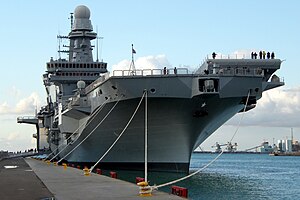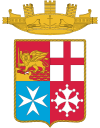
An aircraft carrier is a warship that serves as a seagoing airbase, equipped with a full-length flight deck and facilities for carrying, arming, deploying, and recovering aircraft. Typically, it is the capital ship of a fleet, as it allows a naval force to project air power worldwide without depending on local bases for staging aircraft operations. Carriers have evolved since their inception in the early twentieth century from wooden vessels used to deploy balloons to nuclear-powered warships that carry numerous fighters, strike aircraft, helicopters, and other types of aircraft. While heavier aircraft such as fixed-wing gunships and bombers have been launched from aircraft carriers, these aircraft have not landed on a carrier. By its diplomatic and tactical power, its mobility, its autonomy and the variety of its means, the aircraft carrier is often the centerpiece of modern combat fleets. Tactically or even strategically, it replaced the battleship in the role of flagship of a fleet. One of its great advantages is that, by sailing in international waters, it does not interfere with any territorial sovereignty and thus obviates the need for overflight authorizations from third-party countries, reduces the times and transit distances of aircraft and therefore significantly increases the time of availability on the combat zone.

A carrier battle group (CVBG) is a naval fleet consisting of an aircraft carrier capital ship and its large number of escorts, together defining the group. The CV in CVBG is the United States Navy hull classification code for an aircraft carrier.

Giuseppe Garibaldi is an Italian aircraft carrier, the first through-deck aviation ship ever built for the Italian Navy, and the first Italian ship built to operate fixed-wing aircraft. Although she is widely recognised as a carrier first and foremost, she is officially designated as an aircraft-carrying cruiser. She is equipped with short take-off and vertical landing (STOVL) aircraft and helicopters. Giuseppe Garibaldi was involved in combat air operations off Somalia, Kosovo, Afghanistan and Libya.

HMS Queen Elizabeth is the lead ship of the Queen Elizabeth class of aircraft carriers and the Fleet Flagship of the Royal Navy. Capable of carrying 60 aircraft including fixed wing, rotary wing and autonomous vehicles, she is named in honour of the first HMS Queen Elizabeth, a World War I era super-dreadnought, which in turn was named after Queen Elizabeth I. The carrier Queen Elizabeth carries her namesake ship's honours, as well as her Tudor rose-adorned crest and motto.

The Italian Navy is the navy of the Italian Republic. It is one of the four branches of Italian Armed Forces and was formed in 1946 from what remained of the Regia Marina after World War II. As of August 2014, the Italian Navy had a strength of 30,923 active personnel, with approximately 184 vessels in service, including minor auxiliary vessels. It is considered a multiregional and a blue-water navy.

Vittorio Veneto was a helicopter cruiser that served with the Italian Navy. Originally intended to be a class of two ships specifically designed for anti-submarine warfare (ASW), only Vittorio Veneto entered into service in 1969, its sister ship Italia being cancelled. Vittorio Veneto was placed into reserve in 2003 and decommissioned in 2006. This ship has the same general layout as the smaller Andrea Doria-class helicopter cruisers, but with two elevators in the flight deck and the hangar below, rather than with the hangar as part of the superstructure. It was named for the decisive Battle of Vittorio Veneto which ended World War I on the Italian front.

An amphibious assault ship is a type of amphibious warfare ship employed to land and support ground forces on enemy territory during an amphibious assault. The design evolved from aircraft carriers converted for use as helicopter carriers. Modern designs support amphibious landing craft, with most designs including a well deck. Like the aircraft carriers they were developed from, some amphibious assault ships also support V/STOL fixed-wing aircraft and have a secondary role as aircraft carriers.
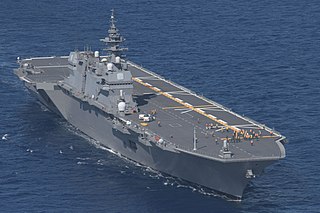
The Izumo-class destroyers are helicopter destroyers in service with the Japan Maritime Self-Defense Force (JMSDF). The official classification of these ships is DDH, which is accepted by the United States Naval Institute; in contrast, Jane's Fighting Ships describes this official classification, but the classification is simply "helicopter carrier".
Operazione White Crane was Italy's military relief operation for Haiti, following the 12 January 2010 earthquake.

JS Izumo (DDH-183) is a helicopter carrier which, as of 2022, is being converted into a light aircraft carrier. Officially classified as a multi-purpose operation destroyer, she is the lead ship in the Izumo class of the Japan Maritime Self-Defense Force (JMSDF). She is the second warship to be named for Izumo Province, with the previous ship being the armored cruiser Izumo (1898).

INS Vikrant is an aircraft carrier in service with Indian Navy. The carrier is India's fourth carrier and the first to be built in India. It was constructed by the Cochin Shipyard Limited (CSL) in Kochi, Kerala. The namesake Vikrant is a tribute to India's first aircraft carrier INS Vikrant (1961). Vikrant means "courageous" in Sanskrit. The motto of the ship, "जयेम सम् युधिस्पृधः" (Sanskrit), means "I defeat those who dare to challenge me" (English).
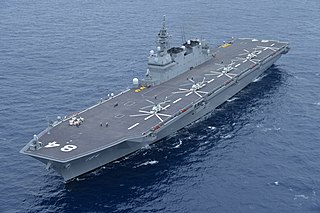
JS Kaga (DDH-184) is a helicopter carrier of the Japan Maritime Self-Defense Force (JMSDF). Officially classified as a multi-purpose operation destroyer, she is the second ship in the Izumo class, the other being JS Izumo. Her namesake arises from Kaga Province in present-day Ishikawa Prefecture.
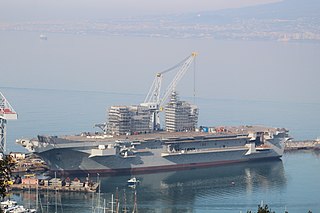
Trieste is a multi-role amphibious unit of the Italian Navy, officially classified as a landing helicopter dock, it will be the largest vessel in the Italian fleet. It was ordered as part of the 2014–2015 naval program and was built at the Castellammare di Stabia shipyards of Fincantieri.

The Italian Naval Aviation is the naval air component of the Italian Navy composed of around 2000 men and women and 69 aircraft and helicopters.

The Thaon di Revel class is a class of multipurpose offshore ships built by Fincantieri for the Italian Navy.
It is planned to replace four Soldati-class light patrol frigates and eight Minerva-class corvettes between 2021/2035. As part of the 2014 Naval Law, a total of sixteen ships are planned and as of 2019 seven vessels have been financed with three more on option.

The Etna class is a ship class of two naval replenishment and logistic support ships used by the Italian Navy and by the Greek Navy The two ships are almost identical but they have differences in their armament and sensor equipment.

Carlo Bergamini(F 590) is a Carlo Bergamini-class frigate of the Italian Navy. Which in turn were developed by the FREMM multipurpose frigate program.

Alpino(F 594) is a Carlo Bergamini-class frigate of the Italian Navy. Which in turn were developed by the FREMM multipurpose frigate program.
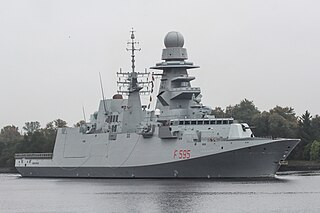
Luigi Rizzo(F 595) is a Carlo Bergamini-class frigate of the Italian Navy which were developed from the FREMM multipurpose frigate program.
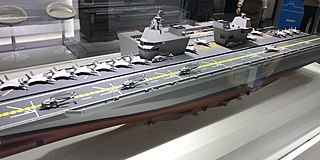
The CVX is a class of aircraft carriers proposed for the Republic of Korea Navy. The class is follow-on from the previous Dokdo-class amphibious assault ships which prioritized amphibious capability, while the CVX will be designed for fixed wing and rotary wing operations instead, constituting a traditional aircraft carrier. The planned development of the class was formally announced and funded as part of the 2020~2024 Mid-Term Defense Plan (국방중기계획), published in December 2020. The Korean presidential administration that entered power in 2022 is not supportive of the CVX project, and it was not funded in the 2023 and 2024 defense budgets.
